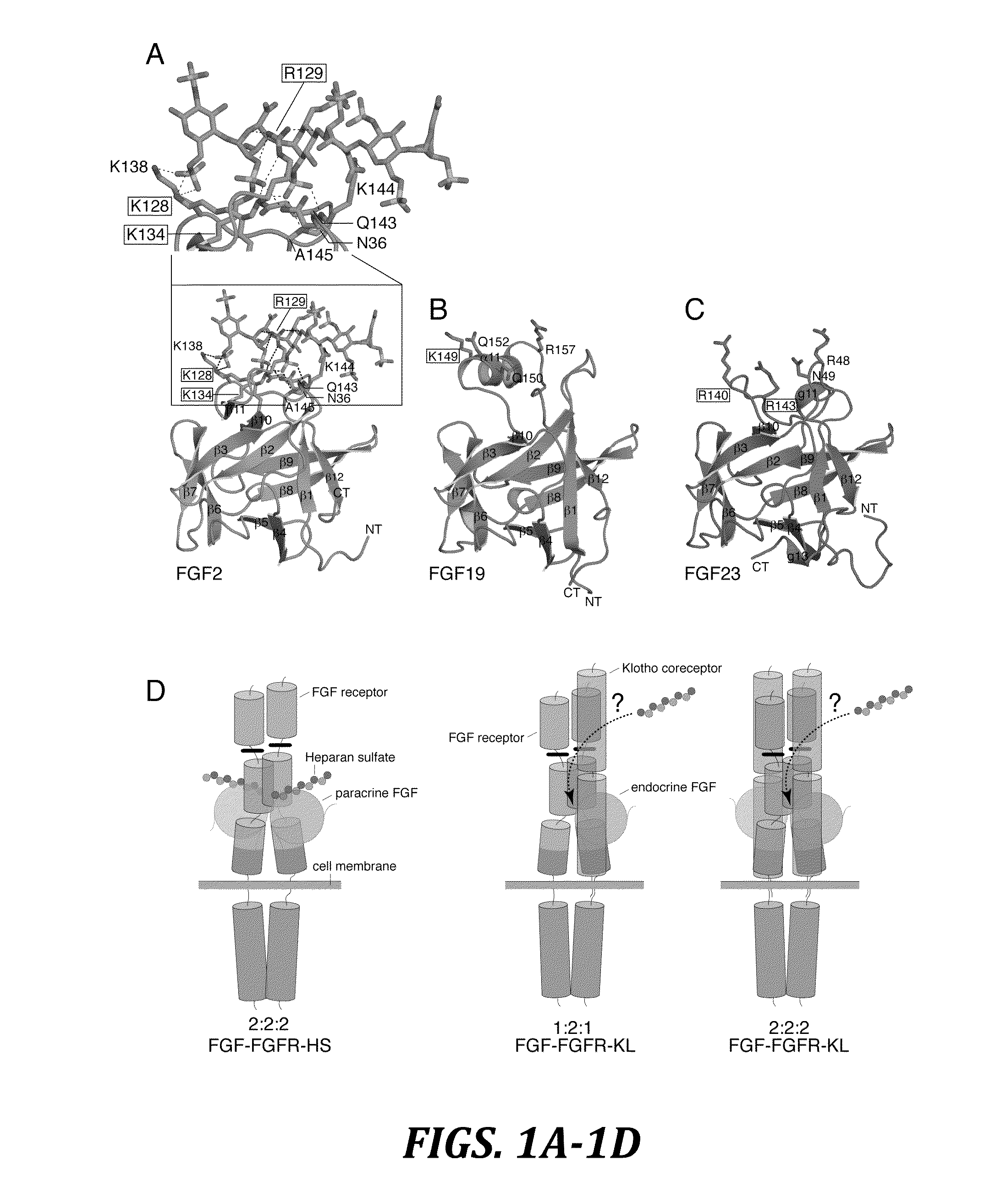Chimeric fibroblast growth factor 19 proteins and methods of use
a growth factor and fibroblast technology, applied in the field of chimeric fibroblast growth factor, can solve the problems of limited efficacy, limited tolerability, and increased irreversible damage to multiple organs, and achieve enhanced endocrine activity, enhanced endocrine activity, and decreased affinity of fgf protein
- Summary
- Abstract
- Description
- Claims
- Application Information
AI Technical Summary
Benefits of technology
Problems solved by technology
Method used
Image
Examples
example 1
Purification of FGF, FGFR, and Klotho Proteins
[0154]The N-terminally hexahistidine-tagged, mature form of human FGF19 (SEQ ID NO: 233) (R23 to K216), human FGF21 (SEQ ID NO: 332) (H29 to S209; FIG. 5A), and human FGF23 (Y25 to I251; FIG. 5A) was refolded in vitro from bacterial inclusion bodies, and purified by published protocols (Ibrahimi et al., Hum. Mol. Genet. 13:2313-2324 (2004); Plotnikov et al., Cell 101:413-424 (2000), which is hereby incorporated by reference in its entirety). The amino acid sequence of human FGF23 (SEQ ID NO:345)(GenBank accession no. AAG09917, which is hereby incorporated by reference in its entirety) is as follows:
1MLGARLRLWV CALCSVCSMS VLRAYPNASP LLGSSWGGLI HLYTATARNS YHLQIHKNGH61VDGAPHQTIY SALMIRSEDA GFVVITGVMS RRYLCMDFRG NIFGSHYFDP ENCRFQHQTL121ENGYDVYHSP QYHFLVSLGR AKRAFLPGMN PPPYSQFLSR RNEIPLIHFN TPIPRRHTRS181AEDDSERDPL NVLKPRARMT PAPASCSQEL PSAEDNSPMA SDPLGVVRGG RVNTHAGGTG241PEGCRPFAKF I
[0155]HS-binding site mutants of FGF19 (K149A) and FGF23 (R14...
example 2
Analysis of FGF-Heparin and FGF-FGFR-α / βKlotho Interactions by Surface Plasmon Resonance Spectroscopy
[0157]Surface plasmon resonance (SPR) experiments were performed on a Biacore 2000 instrument (Biacore AB), and the interactions were studied at 25° C. in HBS-EP buffer (10 mM HEPES-NaOH, pH 7.4, 150 mM NaCl, 3 mM EDTA, 0.005% (v / v) polysorbate 20). To study endocrine FGF-heparin interactions, a heparin chip was prepared by immobilizing biotinylated heparin (Sigma-Aldrich) on flow channels of a research-grade streptavidin chip (Biacore AB). The coupling density was ˜5 fmol mm−2 of flow channel. To measure binding of chimeric FGF2 proteins to heparin, biotinylated heparin was coupled to a streptavidin chip at an approximately 4-fold lower density as judged based on the binding responses obtained for FGF1. To study FGF-FGFR-α / βKlotho interactions, FGF chips were prepared by covalent coupling of FGF proteins through their free amino groups on flow channels of research grade CM5 chips (B...
example 3
Analysis of Phosphorylation of FRS2α and 44 / 42 MAP Kinase in Hepatoma and Epithelial Cell Lines
[0163]To examine whether the FGF19K149A and FGF23R140A / R143A mutants can activate FGFR in a α / βKlotho-dependent fashion, induction of tyrosine phosphorylation of FGFR substrate 2α (FRS2α) and downstream activation of MAP kinase cascade was used as readout for FGFR activation. Subconfluent cells of the H4IIE rat hepatoma cell line, which endogenously expresses βKlotho (Kurosu et al., J. Biol. Chem. 282:26687-26695 (2007), which is hereby incorporated by reference in its entirety), were serum starved for 16 h and then stimulated for 10 min with the FGF19K149A mutant or wild-type FGF19 (0.2 ng ml−1 to 2.0 μg ml−1). Similarly, subconfluent cells of a HEK293 cell line ectopically expressing the transmembrane isoform of murine αKlotho (Kurosu et al., J. Biol. Chem. 281:6120-6123 (2006), which is hereby incorporated by reference in its entirety) were treated with the FGF23R140A / R143A mutant or wi...
PUM
| Property | Measurement | Unit |
|---|---|---|
| binding affinity | aaaaa | aaaaa |
| affinity | aaaaa | aaaaa |
Abstract
Description
Claims
Application Information
 Login to View More
Login to View More - R&D
- Intellectual Property
- Life Sciences
- Materials
- Tech Scout
- Unparalleled Data Quality
- Higher Quality Content
- 60% Fewer Hallucinations
Browse by: Latest US Patents, China's latest patents, Technical Efficacy Thesaurus, Application Domain, Technology Topic, Popular Technical Reports.
© 2025 PatSnap. All rights reserved.Legal|Privacy policy|Modern Slavery Act Transparency Statement|Sitemap|About US| Contact US: help@patsnap.com



